
A common thread among old-time shooters is the deadly effect of the 22 Winchester Magnum Rimfire cartridge. Long recommended as a woman’s cartridge, the WMR is seen as a better choice than the 25 ACP or 32 ACP. Also commonly known as the 22 Magnum, the round is hailed as a fine choice for anyone who cannot handle the recoil of a 38 Special revolver. The popularity of 22 Magnum NAA Mini Revolvers is based largely upon this impression. The recommendation for the 22 Magnum has been given so many times that it seems to be accepted without research to back up the facts.
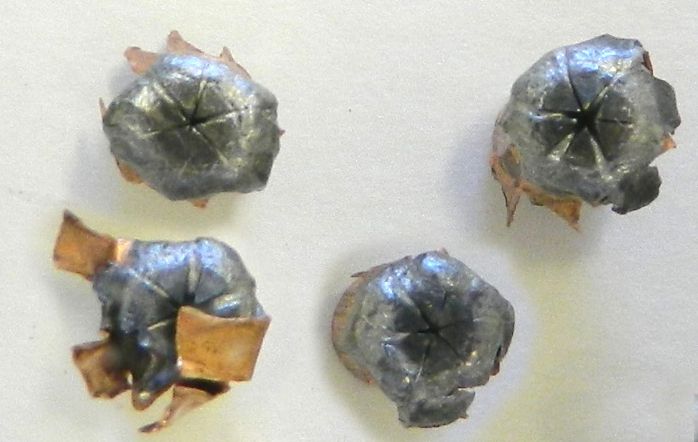
Is the 22 Magnum a credible alternative to the 38 Special? Probably not, we thought, but then there is another alternative to the 38 Special aside from the 32 Magnum. There are drawbacks to either cartridge other than the lack of bullet width and bullet mass. The 22 Magnum demands a strong hammer spring to smack the primer hard enough to ensure rimfire ignition. As a result, the 22 Magnum revolver cannot be produced with an action as smooth as a comparable 32s or 38s. A female with less hand strength may find the 22 Magnum taxing. It kicks less, but guns chambered for it may be more difficult to manipulate. The 22 Magnum cannot be modified to a smoother action and retain reliable ignition. Also, 30- and 40-grain bullets used in many 22 Mag loads cannot disrupt much tissue. Instead, the long suit of the 22 Magnum is penetration, as our tests showed.
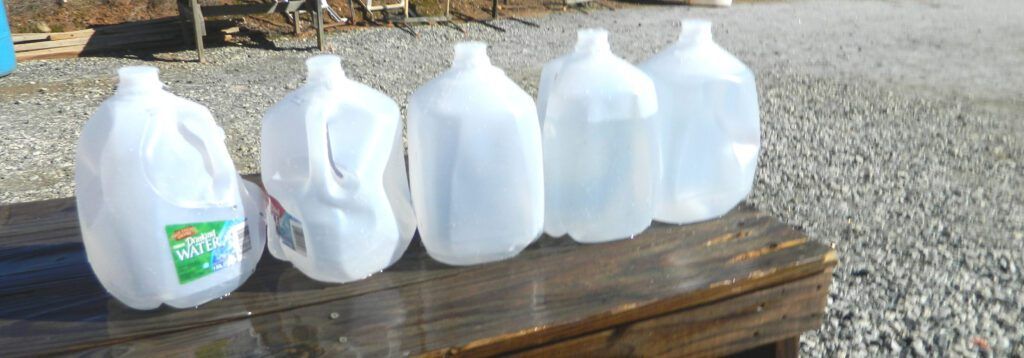
For 22 LR fans, the 22 Magnum is more resilient against water, oil, and solvent and is also less likely to be damaged in handling than the 22 Long Rifle. This is because the 22 Magnum uses a jacketed bullet that is crimped in place, while the shorter 22 LR uses a lead heel-based bullet that is wedged into the cartridge case. Another knock on the 22 Magnum is that the original loads were designed for use in a rifle, and since slow-burning powder is used, they are not optimum in a revolver barrel. One of our raters recalls clocking a 40-grain FMJ Magnum at only 940 fps from his 4-inch kit gun. But that was two decades ago, and we thought perhaps the modern crop would be better — and it was. The test had to be conducted with a revolver with a barrel length common to personal-defense handguns. Since none of the raters owned a 22 Magnum with a short barrel, we went to the pawn shops scrounging for an inexpensive 22 Magnum revolver with a short barrel. That isn’t an easy task. They tell us at the shops that 22 Magnum revolvers are always in demand. Our test gun wasn’t the type normally associated with personal defense, but it was a good compromise. We found a Heritage 22 Magnum (with 22 LR cylinder) in a pawn shop on the cheap. Since it is the birdshead grip model with 3-inch barrel, it neatly split the difference between the short barrel found on NAA Mini Revolvers and the typical 4-inch barrel of 22 Magnum kit-gun-type revolvers. Also, it was large enough for good accuracy and to handle well during the test program. On the other hand, the barrel is short enough for a realistic assessment of the cartridge in short-barrel revolvers.
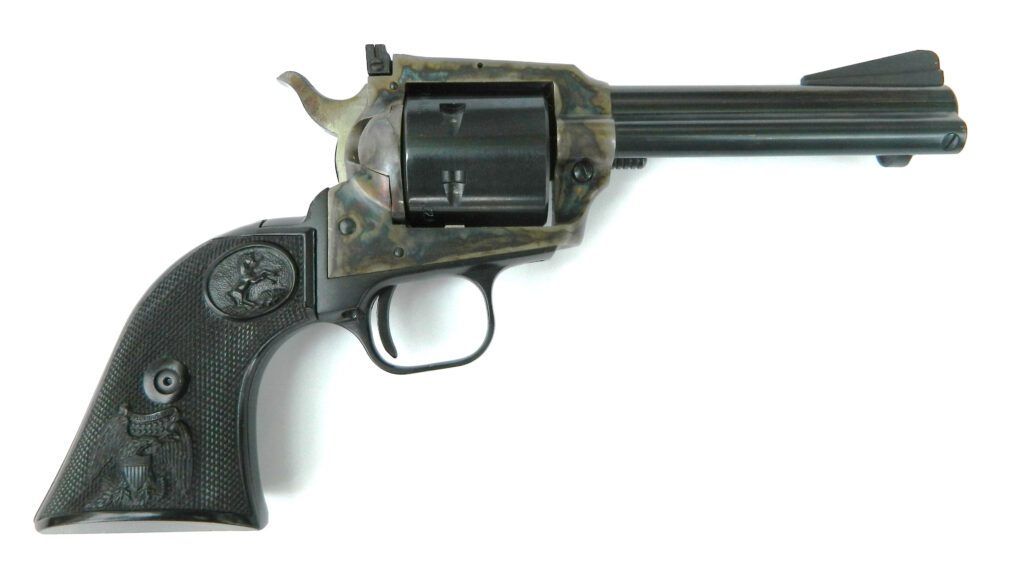
The primary focus of this test was the 22 Magnum, but we also included a number of 32 Magnum loads for comparison. Compared to the 38 Special, the 22 Magnum and 32 Magnum each offer six shots rather than the five shots of a 38 Special in a small-frame revolver. Each also offers low recoil. Both are popular alternate choices, but the 22 Magnum is far more widely used because of the availability of NAA Mini Revolvers. We realize such small guns are controversial for personal defense, and we want to be clear we’re not advocating 22 Mags for personal defense. But many people do use them for that, so it’s incumbent on us to see what the rounds can really do in our tests.
During the firing tests, the excellent control of the 22 Magnum was noted. One rater was able to fire the single-action 22 so quickly he was able to put three bullets into the jugs before the water drained, with the three bullets resting neatly in place at the bottom of the third jug. That is control! The little Heritage revolver was simply the platform for the test program, but all that shot it commented on the excellent trigger and great handling.
Hornady 25-grain NTX
Lead Free 83201, $12.99/50
(Midway #850909)
This loading is designed for hunting in California’s lead-free areas. It is a fine load for that purpose when fired from a rifle. We thought that perhaps this was a load with plenty of velocity that might fragment and produce low penetration. In fact, the slower-burning powder did not produce great velocity, and the bullet failed to expand at all. This is a rifle-only load that, while accurate, offers neither penetration nor expansion for personal defense. Perhaps an unfair comparison, but we had to know what it would do.
Hornady 30-grain V-Max 83202
$10.79/50 (Midway #764567)
This load performed little different than the 25-grain load. The only noticeable difference was that the polymer insert was blown out of the nose in about half of the rounds tested. These Hornady loads are designed for varmint shooting from rifles, and we suspect shooters savvy enough to choose one or the other will realize that. Just the same, they perform differently from other lightweight bullets.
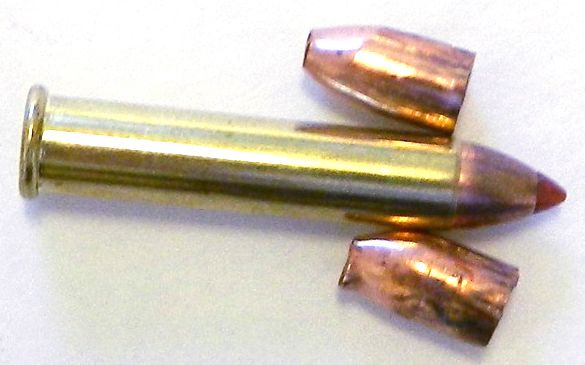
Winchester 30-grain
JHP S22M2, $17.56/50
(Midway #365873)
This is a crackerjack load for use in pistols, for disposing of varmints, and for small-game hunting with a pistol. The load has plenty of velocity and fragments in water even when fired from the short-barrel Heritage revolver. Expansion was certainly there, and the load is quite accurate, probably more accurate than reflected in a 3-inch barrel revolver with fixed sights.
The raters were divided on whether the penetration exhibited was adequate, and most wished for more penetration. Others felt that the fragmenting bullet was worth paying attention to.
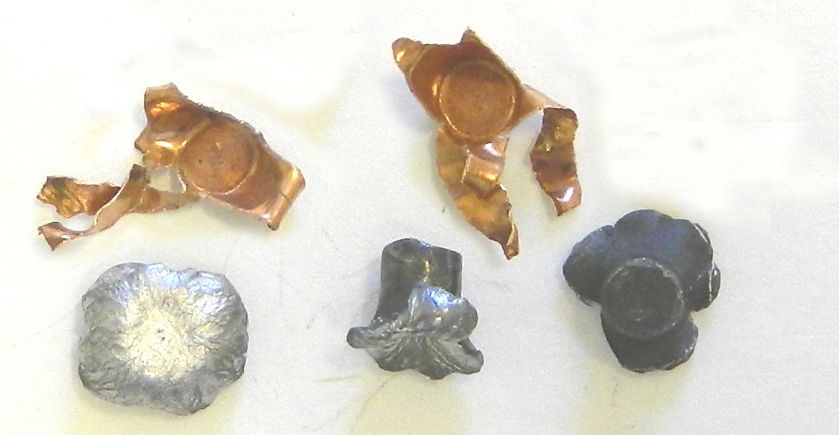
CCI Maxi-Mag 40-grain
JHP 0024, $110.99/500
(Midway #837373)
CCI Maxi-Mag 40-grain
TMJ 0023, $100.99/500
(Midway #228225)
This is a classic load, accurate, clean burning and breaking over 1000 fps even in the short NAA arms revolver. Penetration is the greatest of any load tested at well over 12 inches. The FMJ load would not be expected to penetrate any more because the CCI JHP doesn’t expand at all. The bullet could have been reloaded and fired again. However, if you value penetration, and that is the long suit of the 22 Magnum by reputation‚ the CCI Maxi Mag produces the requisite depth. The JHP might expand if it hit bone, but the fact is, it really needs rifle velocity to open up. The load received a B rating because it has penetration and reliability.
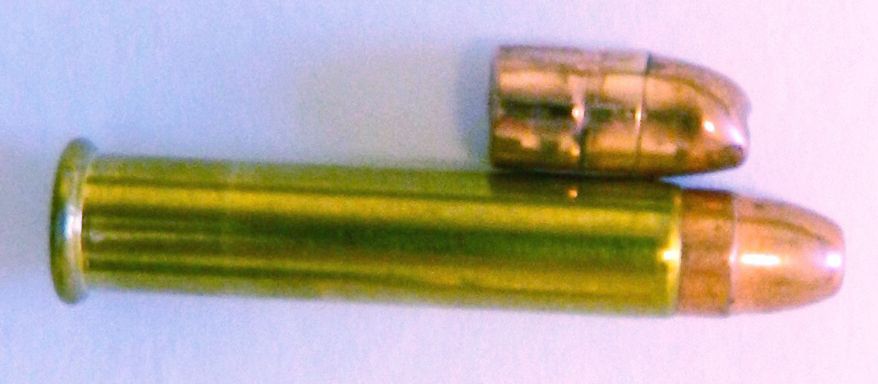
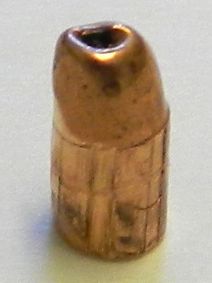
Hornady 45-grain Critical
Defense FTX #83200, $13.49/50
(Midway #994134)
This Hornady load is among a very few loads specifically designed for use in a short-barrel handgun and it shows. Bullet weight is ideal and the bullet expanded reliably and retained all of its weight. Bullet expansion was very uniform. No bullets failed to expand, but some did expand slightly more than others, and expansion was ragged in some cases. Quite possibly a 4-inch-barrel revolver would produce better results, but the test clearly showed that Hornady has been at work developing a potent 22 Magnum loading.
Our Team Said: General-purpose 22 Magnum loads, designed for a rifle and pushed into service in a handgun, simply cannot compete. The Hornady Critical Defense load is ideal for use in a self-defense handgun.
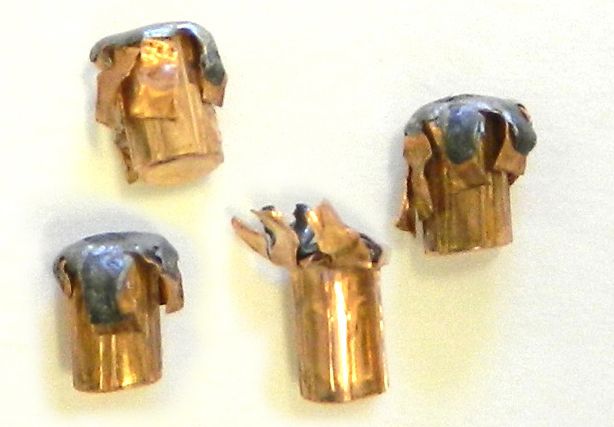
Black Hills 32 Magnum 85-grain
JHP D32H&RN1, $35.78/50
(Midway #140646)
Federal Personal Defense
32 Magnum 85-grain JHP
C32HRB, $18.79/20
(Midway #117808)
The 32 H&R Magnum isn’t a Magnum by most standards, and in fact the results from this cartridge are often disappointing. However, the 32 Smith & Wesson Long 98-grain RNL loading seldom produces more than 700 fps from a 4-inch barrel, so the 32 H&R Magnum is an improvement.
The 32-caliber bullet used in the 32 Magnum doesn’t expand to the required bullet diameter we expect from a defensive caliber. It just doesn’t measure up, in our opinion, but if you cannot handle a 38 Special for one reason or the other, the 32 Magnum is considered an option.
Since our primary focus was the 22 Magnum, only two loads were tested. But, then, there isn’t a lot to choose from. Per our tests, the 22 Magnum, based on superior performance and greater economy along with low recoil, would be the winner.
Power factor with the 32 is twice what it is with the 22 Magnum, and when you are looking for low recoil, the difference is noticeable, particularly to senior shooters. Plus, you cannot stuff a 32 in the North American Derringer.
The 32 Magnum costs twice as much as the 22 Magnum but clearly doesn’t deliver twice the performance. One 32 load expanded slightly more, one had greater penetration, both are practically equal.
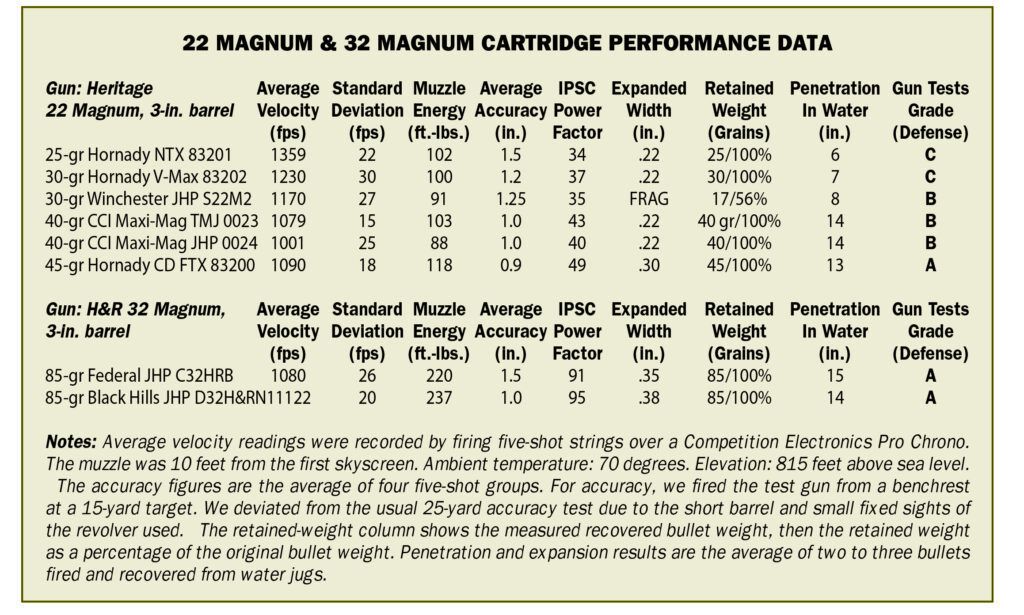
Written and photographed by R.K. Campbell, using evaluations from Gun Tests team testers. GT



























Next time you might want to include Federals “Punch” ammo in the .22 Mag testing
Would love to see how that Hornaday 45 gr Critical Defense does in a Keltec PMR30.
On hogs at my Ranch the PMR 30 with the Hornady 45gr. is sudden death for hogs at close range head shots 50 Yards and less. Great Ammunition Fantastic Pistol
Kel-Tec PMR30